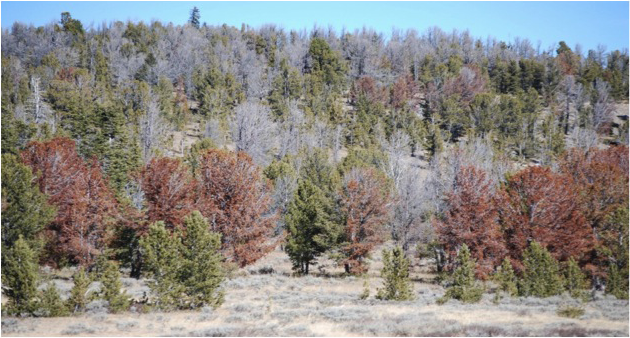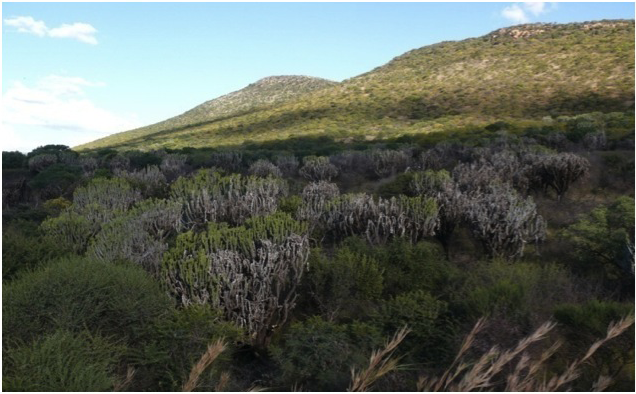

Climate, Forests & Insects: From Montana Whitebark Pine to South African Euphorbia Diana Six, PhD
Diana Six is a professor at the University of Montana. She focuses her research on the evolution and maintenance of symbioses - particularly those occurring among bark beetles, ambrosia beetles and fungi - and she conducts research on various aspects of bark beetle ecology and management. Diana Six has recently expanded her focus to include how changing temperatures affect symbioses, ecosystem function and diversity. She also investigates the role of climate change on extensive die-offs of South African trees. She has authored more than 50 peer-reviewed papers, and recently published an editorial on climate change and mutualism in Nature Reviews Microbiology.
Today I’m going to talk a little bit about interactions between climate, forest and insects. I thought a good place to start would be to give a short introduction into why we are particularly interested in insects and climate change. I’m going to talk a little bit about some of the factors that have some pretty strong impacts on insect populations, and then I’m going to talk about a couple of systems that I work in currently where we’re already seeing some really dramatic impacts. These include whitebark pine in our western and subalpine ecosystems, and also South African giant euphorbia trees.
I like to call insects, “nature’s first responders.” That’s not because they’re the first ones to show up and provide first aide to our forests when they’re in trouble. Actually, it’s quite the opposite. Insects are incredibly sensitive to even small amounts of environmental change. When you think about forest insects, the environmental triggers that they really respond to most rapidly are temperature and host tree stress. Insects are what we call ectotherms, which means they can’t really regulate their own body temperatures, leaving them very much at the mercy of the environment. For all of their vital rates, such as activity, feeding, reproduction and development, as things cool down all of those rates slow down. Conversely, as you increase temperature, all of those rates increase. It doesn’t take much of a change in temperature to see a big change in those rates.
For a lot of insects, a two-degree change in temperature will cause approximately a doubling of things like reproduction and development, which can really rapidly impact population growth. Something else that’s really important with forest insects is the state of the condition of the tree host. For example, we have a bit of warming and drying across the west, and that’s expected to continue. That puts a lot of stress on trees, which has the effect of really lowering their defenses and making them easy food for insects, which can also greatly contribute to their population growth.

Figure 1: Pinyon ips trees in Wind Rivers, Wyoming killed by bark beetles. Photo credit: Diana Six
Living in Aspen and Colorado, you know we already have some very rapid responders, and some of these are bark beetles. It has been pretty amazing for us entomologists to see how three bark beetle species have already responded primarily – not completely, but primarily – to the changes in climate. This has been primarily driven by a few degrees increase in temperature, which allowed insects like the spruce beetle to go from a two-year life cycle to a one-year life cycle. If you’re a bark beetle, that’s really important.
In a two-year life cycle you’ve got to get through two winters, which is bad enough. Even worse, you have to be able to feed and get moisture out of a tree that’s been dead for two years. If you look at a tree that’s been dead a year, you can see that that’s probably not going to happen too much. It really regulated their populations. When they switch to a one-year life cycle they took off and we got this massive epidemic. The pinyon ips, bark beetle (see Figure 1) was also driven very much by a hot/dry weather, stressing trees and allowing this particular non-aggresive bark beetle, to take off and create an epidemic that has probably has altered those forests forever.
It is normal for mountain pine beetle to have periodic outbreaks. This has been the case for thousands and thousands of years. But it’s very, very different now. This outbreak is much more extensive, much more severe, and some other things are also very different. The beetle has expanded its geographic range much further north because it’s now warm enough to survive there. It has jumped the continental divide and it is now found in Alberta, all the way up into the jack pine forests. The fear now is that it will move across the continent and into our eastern pine forests.

Figure 2: Pitch tubes. Photo credit: Diana Six
Something else that’s different with mountain pine beetle is that it has also moved up in elevation, and that’s one of the systems I work in. I’d like to introduce what’s happening now with mountain pine beetle in our subalpine whitebark pine forest. If you know about whitebark pine, this is the tree that’s up at the highest elevations. It is the keystone species that keeps that ecosystem together. The beetle didn’t used to do well up in the high elevations because it was too cold. It had a two-year life cycle, which is quite maladaptive. It is now warm enough for that beetle to go through in one generation, so it’s doing very well up there.
We’ve had a couple of outbreaks we know of in whitebark pine in the past, but they were due to very short term pulses of warm dry temperatures, (in the 70’s and with the dustbowl and so forth). What happened there was once it returned to normal cooler weather conditions, the beetle pretty much got shoved off the mountain. The problem now is that we’re not expecting to return to these cooler weather conditions, so we think the beetles currently up there will stay. The extent of the outbreak now is much, much bigger than it was in the past. We think that we’re probably going to lose this tree across most of its range, and it won’t recover. It’s a permanent alteration of this ecosystem.

Figure 3: Boring dust from bark beetles in a White Bark Pine tree. Photo credit: Diana Six
Something we’re noticing with mountain pine beetle in white-bark pine is that it goes through that tree very fast. If you look at lodgepole pine, it takes about 7-10 years for the beetle to work through. With whitebark pine, it’s three. We can’t even keep our study sites going. You find a site with a few dead trees, the next year it’s 50%, and the next year it’s 90-100%. This right here is just a two-year progression. Part of that, we think, is that the tree really doesn’t have much in the way of defenses because it hasn’t really had to battle a beetle. This is what you would see with ponderosa or lodgepole pine: the tree trying to pitch the beetles out (see Figure 2). When you look at whitebark pine that has been attacked by a beetle, what you see is boring dust (see Figure 3). The beetles are just walking in and there’s no fight.

Figure 4: Yellowstone/Wind Rivers, Wyoming from above. Photo credit: Ecoflight
This is what Yellowstone, the Tetons and the Wind Rivers in the high elevations look like right now, over a million hectares dead already just in the greater Yellowstone ecosystem (see Figure 4). Again, we don’t believe this tree is going to be coming back. It’s probably a permanent shift in our subalpine ecosystem.
I’d like to talk about this other system that I also work in, and that’s looking at the Southern African giant euphorbia tree. Starting in about 2000, people started reporting massive really rapid die-offs of this incredible, large succulent tree. It looks like a saguaro except on major steroids. This thing is about 35-40 feet tall, almost as wide when they’re mature. They are really magnificent, considered a national treasure, and they’re dropping dead (see Figure 5). At first the suspect was an exotic pathogen or an insect that might have gotten in. They did notice that these trees were very, very heavily attacked and often killed by ambrosia beetles, which happen to be relatives of the bark beetles. Then of course, climate change was also suspected.

Figure 5: South African Giant Euphorbia tree dying off. Photo credit: Diana Six
One of my colleagues in South Africa, Jolanda Roux, a plant pathologist, and I have been looking at these trees for about six years. We’ve cataloged all the diseases and insects. They all appear to be native, and they all appear to be benign. Even the ambrosia beetles, typically only attack trees that are very, very stressed.
We began to look at the potential that a changing climate might be driving this. These are some data from one our sights (we have several). It’s from a place called Last Post, which is a wildlife reserve. It’s very well protected. It’s an interesting place to work that is intermediate in damage. It is not one of our extreme sights. What we found, looking at the weather data that was available for the last 40 years, was that at the beginning of that period, temperatures were overall cooler and precipitation was higher. The intermediate years were highly variable with big swings in temperature and precipitation from year to year. Then the last period (approximately 10 years) was dry and hot. The thing that is most important to consider here is precipitation. Now that we’ve moved into a period where it’s hot, where there’s a lot more demand for moisture, the trees are getting a lot less. From these data we’ve been able to calculate something called potential evapotranspiration, which is the estimated amount of the loss of moisture from the vegetation at these sites (that’s the output). Then we look at the input which is precipitation and determine if there’s a deficit and how much. For each of the sites where we see trees tipping over the edge, we find a particular deficit that appears to be a threshold. Once trees hit that threshold they begin to decline and die within about two years. It’s a constant signal across these sites.
This is my take home message: we see more and more insects developing these large outbreaks. The thing to remember is, when you’re dealing with insects they are responders. If you’re going to think about managing an insect or trying to deal with their impacts, it’s very important you realize that actually they’re responding to something, and that just focusing on insects is probably not going to be very successful. You have to go to the ultimate cause of that response. Unfortunately more and more, the cause is climate change. So if we’re really going to start dealing with some of these insect problems that are emerging, we have to go to the initial underlying cause.